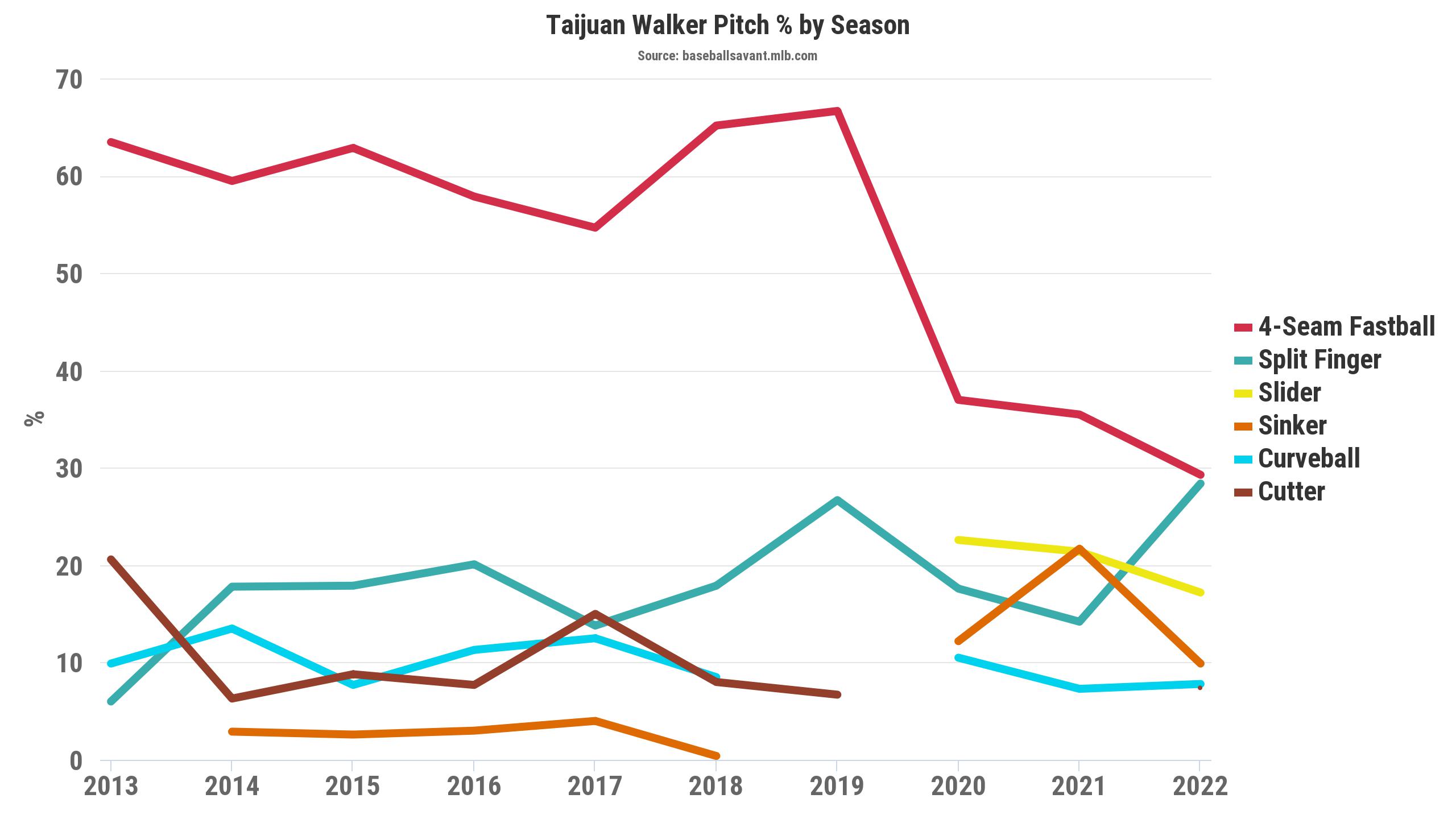Before TJS
Originally drafted by the Seattle Mariners as the 43rd pick in the 2010 amateur draft, Taijuan Walker has made at least one appearance in ten consecutive seasons. Over his decade as a starting pitcher, the 6’4″ righty has bounced around a bit. For his first two full campaigns in the Majors (2015 and 2016), he posted ERAs north of 4.00 with Seattle. In the off-season, Walker was dealt to Arizona. He proceeded to have a breakout 2017 season, posting a 3.49 ERA to accompany a 9-9 record. He picked up where he left off in 2018 with a 3.46 ERA in 13 innings, until a partial UCL tear forced him to undergo Tommy John surgery. He would make just one more start for the Diamondbacks, pitching just a single, scoreless inning towards the end of 2019. Somewhat surprisingly given his pedigree and track record, Arizona non-tendered him after the season ended. That decision has aged poorly.
After TJS
Walker ended up re-signing with the Mariners on a one-year deal entering the shortened 2020 season and started five games for Seattle posting an even 4.00 ERA before being dealt to the Blue Jays. He excelled over his six starts for Toronto, posting a 1.37 ERA, although a 4.14 FIP over that span suggested he was getting some good luck. Still, he wound up finishing 2020 with a strong 2.70 ERA over 11 starts, encompassing 53.1 innings. Walker signed a two-year deal with the Mets beginning in 2021 and was selected to his first MLB All-Star Game that same year thanks to his 7-3 record and the 2.66 ERA he carried over the first half of the season. The second half of 2021 was, uh, not quite as good, but we’ll come back to that later. For now, let’s look at the difference between Taijuan Walker before TJS and post TJS.
Old Team, New Approach
Despite returning to his roots by re-signing with the team that originally drafted him, Walker evolved as a pitcher following his surgery, and big part of that change can be seen in his pitch selection visualized below.

Three major changes between Walker’s pre- and post-TJS arsenal are clear. First, a dramatic drop in his reliance on his four-seam fastball as his primary pitch. Second, the introduction of a slider. Third, and most importantly, the increased use of his splitter this season.
Walker went with his heater for more than 60% of his pitches before he went under the knife, peaking at nearly full two-thirds of all his pitches in 2018. But since he returned after missing most of 2018 (13 IP) and 2019 (1 IP), he’s gone to his four-seamer roughly half as often, with its usage dropping all the way to less than one-third of his pitches thrown this season. This change is not due to any sort of diminished quality in regards to the pitch itself. Walker is throwing his four-seam fastball at the same velocity, about 94 mph, and with the same movement as it displayed in years past. He’s generating a lower K rate and Whiff rate than he previously had with the pitch, but that has not held him back, since he’s relying on it so much less to produce outs.
The Slider
Taijuan debuted his slider in 2020 and has used it approximately 20% of the time. It’s not been an especially effective pitch in terms of run value, but the league as a whole has batted under .200 against it. Walker doesn’t generate a ton of movement or whiffs on the pitch, but it plays well off of his other offerings. He consistently locates it around the lower corner of the strike zone, and the real-life results have been consistently better than the expected ones every year — by considerable margins as well.
The batting average allowed has been trending upward, but still sits under that .200 mark. And while Walker’s slider does get hit hard at a rate well above the MLB average Hard Hit rate of 35.7%, it’s been an effective pitch for him. That has been true especially this year, where the slider has been credited as a plus pitch, saving two runs over the course of the season.
We’re going to see a bit of the same with Walker’s splitter, although we’ll find an even more effective pitch with a much clearer explanation as to why it’s been so good.
Splits Like Van Damme
So, 2020 did not follow the same increasing BA trend when looking at Walker’s slider, but the real stats began to beat his expected ones in 2021, and quite dramatically in 2022. Walker’s splitter has gotten better over the last few years in a couple of key and easily understandable metrics.
There you have it. That right there is the big secret to Walker’s success this season. A seven-inch gain in drop and a corresponding 19-degree drop in launch angle over a couple of seasons are impressive. Among starting pitchers, only Yu Darvish is getting a lower average launch angle off of his splitter. Alex Cobb is the only starter generating a higher ground ball percentage with his splitter. Taijuan is allowing a higher average exit velocity than other pitchers with elite splitters, such as Tony Gonsolin or Kevin Gausman, but since hitters are just pounding it into the ground, that has not hurt him. In fact, Walker’s splitter has been credited with a -14 run differential this season! That is the best mark for any starter’s splitter this year, easily beating 2nd place Gonsolin at -11 runs and Gausman at -8 runs. He has allowed a whopping zero home runs off his splitter this year. I have not seen a splitter this good since Time Cop; it’s become an elite pitch. Walker is throwing quite possibly the best splitter in the majors right now, and adding it to his repertoire, developing it, and utilizing it to an increasing degree have been the best series of decisions he has made so far in his MLB career.
Fantasy Takeaway
Taijuan Walker is an incredibly interesting case study because his success to a large degree defied expectations. A quick glance at his sliders on Baseball Savant would invoke a chilly sensation since there was so much blue. His average exit velocity, Hard Hit rate, K rate, and Whiff rate, all important metrics that are often cited by analysts and experts (even myself), are only barely above the bottom quartile of the league for starting pitchers. His Walk rate, Barrel rate, and Chase rate are the only areas on the chart where he ranks in the upper half of the league. But his “one weird trick that drives hitters crazy” – his elite splitter has been so dominant that Walker has been successful anyway. His current 2.67 ERA is the best mark of his career since his 2014 season, in which he posted a 2.61 ERA over just 38 innings. And his FIP of 3.25 this season is much better than the 3.68 FIP he posted nearly a decade ago in that small sample. There is one last split to mention though…
I did mention earlier that Walker’s second half of 2021 was not quite as good as his first half. His first half ERA last year was 2.66, eerily similar to his current 2.67 mark. His second half, which included 13 starts, produced an ERA of 7.13! After allowing just six home runs before the All-Star break, he allowed 20 home runs over those 13 second-half starts, a whopping 2.8 HR/9. This season, Walker has allowed just four dingers over the first half, but he allowed two (back to back nonetheless) in the first inning of his first start after the break. Granted, he faced the juggernaut New York Yankees lineup, and one dinger came off the bat of the current MLB home run leader, Aaron Judge, but considering his awful final few months of 2021 and the similarities between his two first-half performances, there could be reason for concern that he could run out of gas (2021 was his first full-length season since his TJS). As of now, considering his improvement and increased usage of his splitter, I remain optimistic that Walker’s second half of 2022 will be much better than his second half of 2021.
With most fantasy leagues approaching their trade deadlines soon, I recommend keeping a very close eye on his ability to keep the ball in the park over his next couple of starts. If he can get through his next outings (currently projected for @MIA and vs ATL) allowing one or zero long balls per game I’d feel a lot more comfortable. If he allows three or four balls to leave the yard, I would start sending out offers and looking for other starting pitcher options.
Featured Image by Michael Packard

